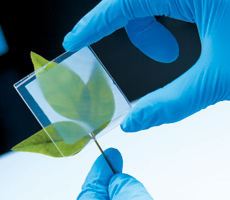- April 14, 2017
- By Charlie Wright
UMD researchers have created a clear alternative to building materials that insulate poorly or keep interiors dark: transparent wood.
Researchers in the university’s Energy Research Center have developed this material, which allows sunshine to pass through, like frosted glass, but can’t be smashed and is more energy-efficient than typical glass windows.
A team of researchers led by Associate Professor Liangbing Hu describe their work developing translucent wood in a paper in the journal Advanced Materials, and recently launched a startup called Inventwood LLC. The team also published a paper on advanced energy materials describing how transparent wood can be an energy-efficient building resource.
The process starts with immersing a 4cm square of wood in a cocktail of chemicals that removes the lignin, the substance that gives wood its brown color, and then infusing the newly translucent block with epoxy to harden it.

Wood doesn’t conduct heat as easily as glass, so instead of heat escaping through a window in the winter and seeping in during the summer, it is trapped inside and blocked outside, keeping the indoor temperature more consistent. Even the grain of the wood is useful.
“You have these very special channels that can guide visible sunlight into the house, independent of where the sun is,” says Tian Li Ph.D. ’15 (above, left), a postdoctoral associate and lead author of the study.
The researchers say the primary challenge now is to develop techniques that allow for them to create larger pieces.
“Right now the scale is a problem, because for any real application you would need at least palm-sized or bigger,” says Amy Gong (above, right), another postdoctoral associate. “We’re limited to the container’s shape.”
The team is also working to decrease the haziness of the wood, hoping to reach the clarity offered by glass windows. Users can easily see objects on the other side of the product only when they are close.
Despite the current limitations, the technology is immensely promising, researchers say.
“Transparent wood can generate tremendous energy savings in daytime lighting and air-conditioning,” Li says.
Tags
Research